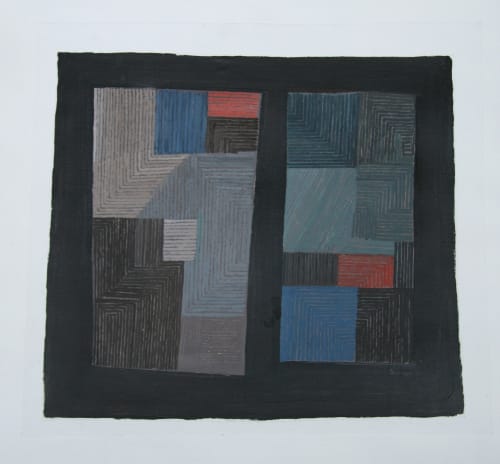Liam Hanley lived in Kentish Town, but his heart belonged to two square miles of undulating fields near Royston in Hertfordshire, which he painted with unending zest and invention. Born in Kensington in 1933, he was the only child of the radical novelist James Hanley, who ran away to sea at the age of 12 and became a friend of such literary figures as TE Lawrence, EM Forster and Henry Green. John Cowper Powys was young Liam’s godfather, and the family lived for many years in Montgomeryshire. Liam inherited his artistic leanings from his mother, herself a painter, collage-maker and writer. It was she, he insisted, who taught him to look. After studying at Wrekin College in Shropshire, Hanley did his National Service in the Royal Marines, in Malta, Libya and Egypt. He then worked as a newspaper and TV journalist for 30 years, but began to grow seriously interested in painting, taking evening classes at the Central School of Art in the late 1950s. In those years he travelled in his spare time and painted whatever caught his eye: he was ‘like a tramp with a bank balance’ (in his own evocative phrase), on the road whenever possible. But Wales remained his main point of reference and many pictures were of the landscape around his old home. His parents sold the Welsh house in 1963, and Liam was bereft. As a painter he felt rootless until he discovered Royston, a stretch of interesting hollows and windswept edges shaped by the Great Surge of the Ice Age.
Hanley took early retirement from ITN to work full-time as a painter. He held his first one-man show back in 1962 at the Royal Society of Arts, and has subsequently exhibited regularly in London, also in Newcastle, Chichester and Kendal. His work, which at one point he wanted to be as accurate a record of the passing seasons as the nature essays of Richard Jefferies, grew more abstract over the years. On occasion geometrical (like Mondrian or Victor Pasmore), it is still lyrical and Romantic, with its high viewpoints and luminous tones. There is also a certain affinity with those American realist painters of the 1950s such as Grant Wood, Thomas Hart Benton, and the fields and big skies of John Rogers Cox.
The early watercolours with their linear Celtic echoes of David Jones (such as Clusters, 1966), developed into the more assured surge and shimmer of the bean-field paintings of the 1980s, culminating in that marvellous celebration of pattern in nature, Misty Landscape, 1987. Later the imagery can be increasingly emblematic, but Hanley never lost sight of the inspiration derived from direct observation, despite the pronounced impulse towards musical structure, as well as a relish for the decorative. His paintings are full of beautiful shapes, not stories. He was a formal painter with a powerful understanding of place. He wrote: ‘I look for landscape that has an echo. Places and shapes have always travelled with us, the stuff of dreams. To find the right landscape is to realise the dream.’
By Andrew Lambirth
